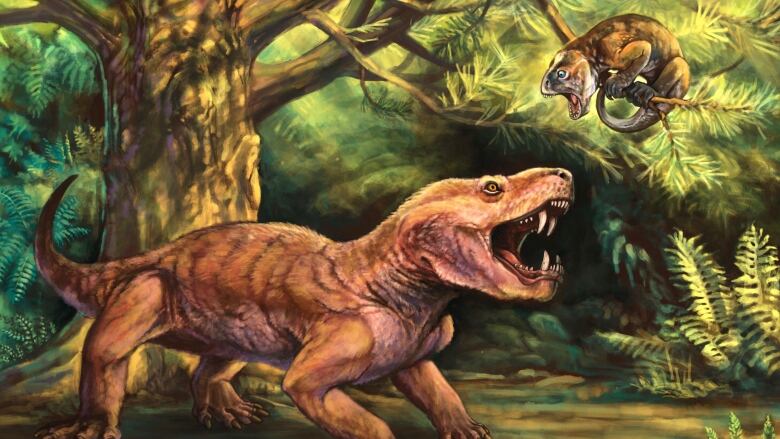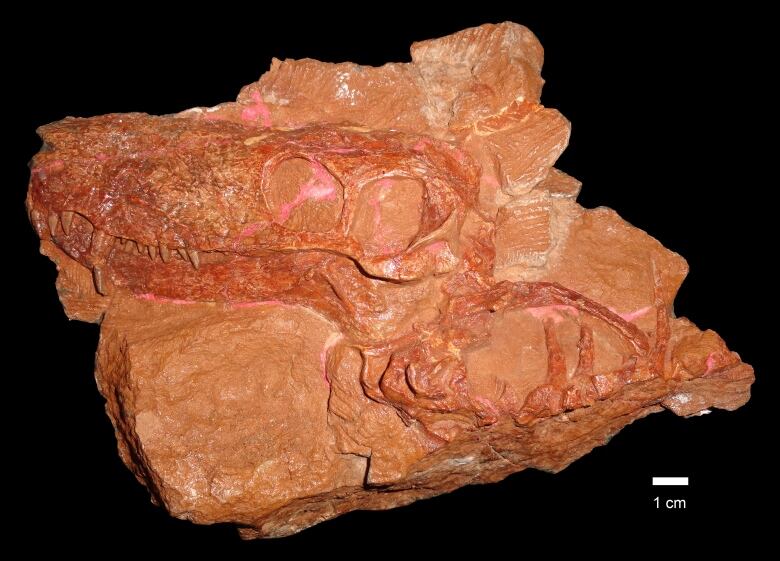'Monstrous' sabre-toothed fossils from Russia shed new light on mammal history
Previously unknown species advance what scientists know about how mammals evolved

One was about the size of a wolf with long, blade-like teeth the dominant predator of its time. The other was a smaller carnivore with a long snout, big eyes and needle-like teeth.
They roamed what is now modern-day Russiabetween 299 and 252 million years ago during what's known asthe Permian Period.
Paleontologist Christian Kammerer of the North Carolina Museum of Natural Sciences and Vladimir Masyutin of the Vyatka Paleontological Museum in Kirov, Russia, describethe two species in studies published Friday in the journal PeerJ.
Named after legendary monsters from Russian folklore, the bigger wolf-like predator is calledGorynychus, afterZmeyGorynych, a three-headed dragon, and the snout-nosed animal Nochnitsa, after a malevolent nocturnal spirit.
New early-mammal insight
Previously, scientists have relied mostly on one site the Karoo Basin of South Africa for their understanding of proto-mammals, the early mammal ancestors who roamed the Earth prior to the first mass extinctionthat brought about the age of the dinosaurs, the Mesozoic. (Later a second and more widely known mass extinction wiped out the dinosaurs and gave way to the current age of mammals.)
South Africa's unique geological featuresmake it a treasure trove for paleontologists who study these early fossils. Unusually, two-thirds of the land area is rock from the Permian period,said Kammerer, lead author. The main reason for that, he says, is that South Africa is a"tectonically stable land mass."

"There has not been any notable volcanism, mountain-building, or earthquakes in South Africa in the past 50 million years or more." But erosion over thattime removed kilometres of rock from the surface, destroying most of thesedimentfrom the dinosaur ageand revealing the ancient Permian rock beneath.
That meant that researchers really weren't sure if the discoveries they made from the South African fossils reflected what was happening with pre-mammal evolution elsewhere on the planet, or just in that location, says Kammerer.
"The reason this Russian site is so nice is because it shows that a lot of the patterns that we have inferred from the South African record hold up worldwide." The researchers learned thatone of the two groups,gorgonopsians,evolved in similar ways despite being separated for millions years in opposite hemispheres on what was then the Earth's onebig super continent.
The Russian fossils were first discovered in the1990sand another in 2008, but it takes years of painstaking work by specialist techniciansusing dental tools and drills to extract them from the ground.
Fossils previously behind the Iron Curtain
Michael Caldwell, professor of biological sciences at the University of Alberta in Edmonton, was not involved in the research, but says it's a step forward to gain more insight into the Russian Permian basin.
During the Soviet era, almostall fossils from within the Soviet sphere, including eastern European countries and places like Mongolia, were concentrated in Moscow,says Kammerer."Since the breakup of U.S.S.R., there have been regional museums opened up, but knowledge of what fossils are there and what research is being done there has been obscure and poorly known in the West."
Visiting Russiafor a conference in 2015, Kammererset aside a few days to visit local museums and laterwishedhe'd planned to stay for weeks.
"I went to this particular museum, theVyatkaPaleontological Museum in Kirov, knowing they had at least some Permian fossils. What I found there was actually quite a treasure trove of incredibly preserved fossils," he says.
While the staff at the Vyatkawere knowledgeable about the Permian record, says Kammerer, "the animals in question are fairly obscure and there are few specialists worldwide working on this." He and his graduate studentsare the only people who work on gorgonopsians, the genus to which one of the two new species belongs.
"So basically if you're not me, you wouldn't know what gorgonopsians looks like," says Kammererwith a laugh.
As a result, the Russian colleagues didn't realize that among their fossils were a couple of previously unidentified species.
The Universityof Alberta's Caldwell said the "spectacular" preservation in the fossil material provides new insight into how anatomical features changed over time.
He says he was struck by the study's findings on the proto-mammals' jaw structure, which include additional bones that in humans and other high mammals have evolved to be part of the inner ear's hearing apparatus.












_(720p).jpg)


 OFFICIAL HD MUSIC VIDEO.jpg)
.jpg)



























































































